Let’s step back to 1964 for a few minutes, into the midst of the SPIW development program. This was the US military’s attempt to increase hit probability from infantry rifles by, basically, changing focus from marksmanship to statistical probability. Studies had shown that hit rates in combat were pretty low, and the main driving theory was that you could get better results overall by using a weapon that fired multiple projectiles simultaneously. In a nutshell:
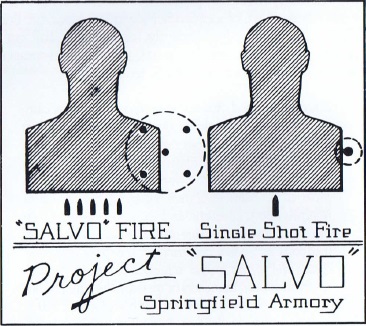
This theory found a number of different incarnations over many years of development, including 5.56 and 7.62mm cartridges with 2 or 3 stacked bullets per cartridge, flechette cartridges, multiple-flechette cartridges, multi-barrel guns, and super-fast burst firing (the H&K G11 is one descendent of these programs). Well, in the early 1960s this type of weapon was slated to replace the M14 – the M16 had been adopted just as a temporary place-holder until the SPIW (Special Purpose Infantry Weapon) was fully developed. The program requirements were pretty ambitious, though, and the companies working on it were having trouble meeting them. There are far too many different experimental guns that came out of the SPIW, SAVLO, and SAWS programs to cover in a single post (the best resource on the whole series of programs is Stevens’ and Ezell’s SPIW: The Deadliest Weapon That Never Was), and so today we’re just going to look at the 1964 bullpup design by Springfield Arsenal.
Actually, we’re mostly going to look at its magazine, because I recently happened to acquire one of them (a mag, not the whole rifle). The requirements at this point in the program called for a minimum of 60 round magazine capacity. The weapon’s lethality was to come from a very high rate of fire with a very light and very high velocity flechette projectile. The cartridge at the time was the XM144, which was a roughly 5.6x49mm case with a single 10.2 grain flechette projectile with a muzzle velocity of 4700 fps.
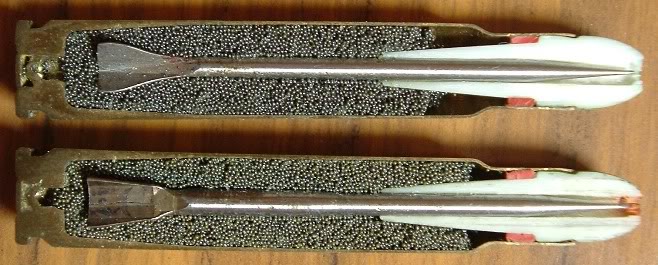
Winchester’s rifle could fire automatically (either unlimited fullauto or 3-round burst) at 1700 rounds/minute (as well as semiauto), so the 60-round magazine capacity requirement did make sense. But how does one carry 60 rounds in a magazine without it being really unwieldy? The XM144 was pretty close to the now-standard 5.56mm NATO in size, so a basic double-stack magazine holding 60 rounds would be both very long and have a spring too strong to effectively load by hand. Springfield’s solution was to make two 30-round magazines and fix them together, one in front of the other:
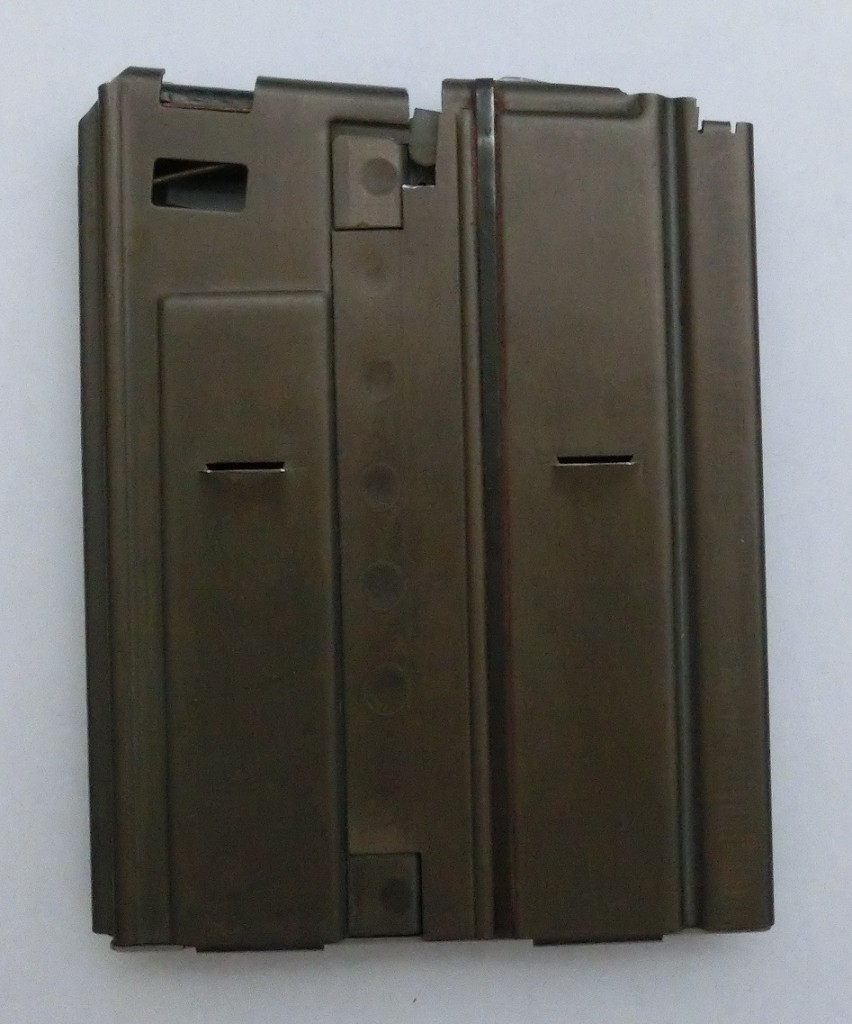
To prevent this rather bulky mag (6″ top to bottom and 4.75″ front to back) from getting in the shooter’s way to badly, Springfield designed their SPIW weapon as a bullpup, so the magazine would sit behind the shooter’s firing hand.
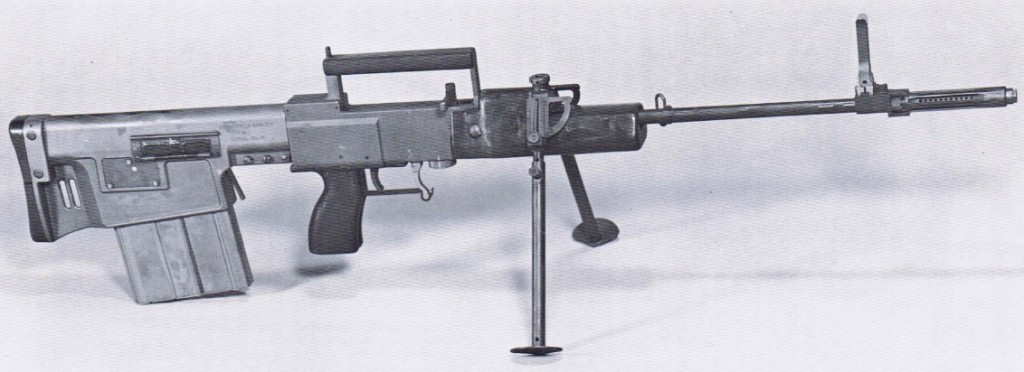
There is one other weapon I’m aware of that used this sort of tandem magazine design, and that is the British experimental Vesely SMG. This SPIW magazine is a more challenging design, though, because it uses a much longer cartridge.
The basic premise is that when both columns are full, a catch in the rifle holds the rear column down slightly, and the bolt picks up cartridges from the front column. As long as it feeds form the front column, everything works in a pretty typical way. Once that front column is empty (a 1.05 second burst), then a pair of tabs on the rear of the front follower trip the catch in the rifle, allowing the rear column of cartridges up into the path of the bolt. The rear column has lips to retain the cartridges, but they do not feed up out of the rear column. Instead, the bolt pushes a round from the rear column into the front column, so that as it round clears the lips of the rear column it is still being controlled by the front set of feed lips. A vertical divider in the front follower forces the cartridges to stay on the left or right side instead of moving into the center of the front column (where the round would pop free of the feed lips. Small follower scallops much like that of an M4 barrel aid in guiding the cartridges over the front follower. Once a round from the rear column is pushed fully into the front column, it then continues to feed like a normal magazine would, into the chamber and ready to fire.
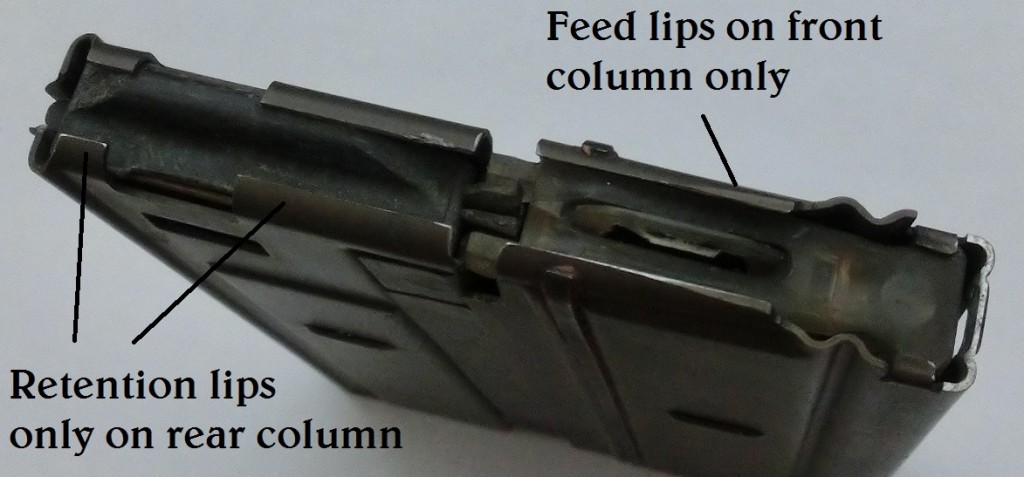
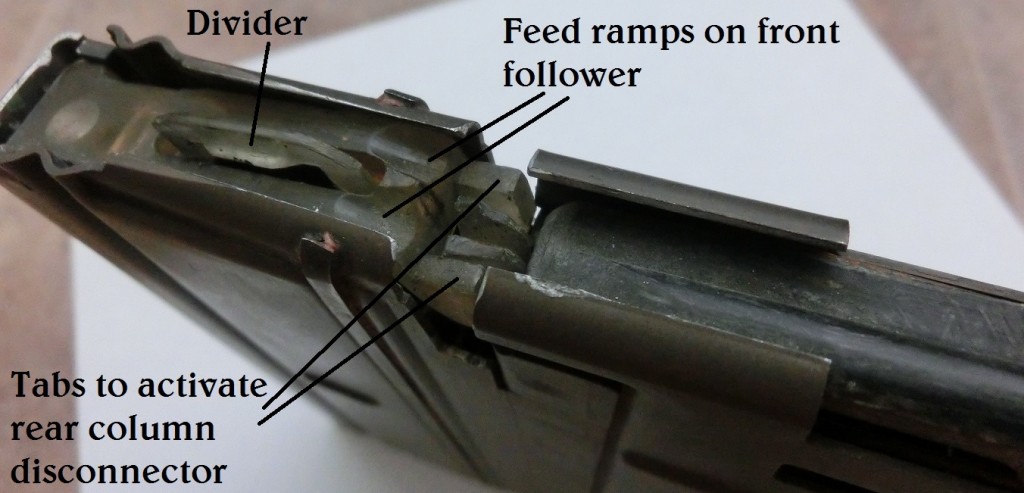
This system seems to have worked at least reasonably well in a controlled environment, but it would have been a disaster in combat. That was acknowledged, and several more years were spend working to perfect the system. Finally, the ammo capacity requirement was dropped to 50 rounds, but most of the subsequent designs turned to using drum-type magazines instead of boxes. And ultimately, of course, none of the many experimental models were found to be good enough for service use, and we still have the M16 to this day.

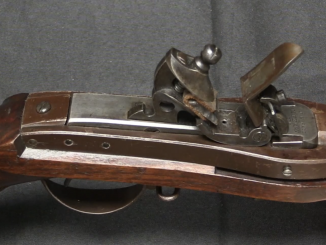
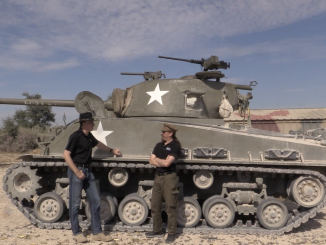
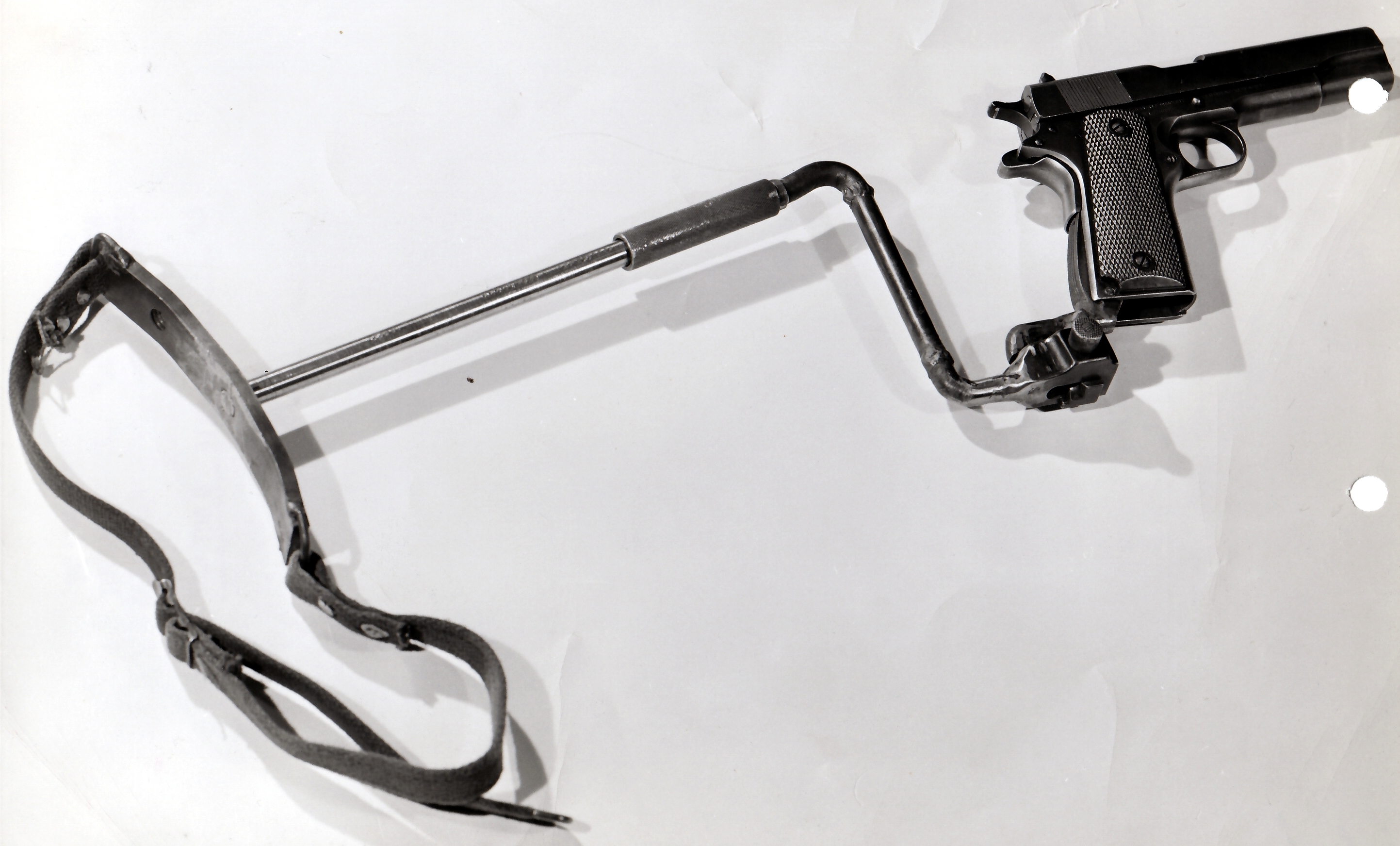
I seem to recall that up until fairly recently ( perhaps 1-2 years ago ), http://www.cheaperthandirt.com was selling surplus flechettes by the pound for reloaders who might want to try their hand at it. I’m not sure which particular size or caliber of flechette was involved, though. Perhaps someone else on FW has had some experience with these?
I love prototypes! It’s so neat to see people’s ingenuity even if it never comes to fruition. That XM144 round and the SPIW rifle both look mean!
I wonder if there were any lethality test with the flechette rounds. It seems that a tiny non expanding projectile would do very little damage even at high speeds.
most reports seem to suggest that you are correct in that assumption, people kept on trying though
Military rounds are supposed to be non-expanding – but no one said anything about tumbling. The flechette is nearly 2″ long, if that starts tumbling it’s going to do a lot of damage.
Mu is correct. Also, the flechette does not have to tumble that much either to cause really serious damage due to its high length-to-diameter ratio. Oscillations about its longitudinal axis alone as it meets resistance from soft tissue, muscle and bone will result in serious peripheral damage.
Also, the whole point of these ultra-high rate of fire weapons was that putting far more bullets (or in this case flechettes) in the air would result in more hits on the enemy. Even if hitting with one flechette wasn’t as lethal as hitting with a traditional bullet, hitting with five of them would put anybody down.
That’s the point many seem to miss, at the end of the day, it’s all about hit probability. A man hit by a single 22LR bullet in a vital area will be a lot more dead than one missed by a hundred 50 cal bullets.
Seems like for the money that was poured down the SPIW rathole, the pentagon could have just paid all future enemy soldiers to go home.
it wasnt so much a program as hope they kept perpetuating
Yeah…but it pales in comparison to the money dumped into a lot of aircraft R&D projects…
touché
One awkward question – a shotgun of course fires just such a cluster of projectiles, and at close range they have quite a reputation for stopping power. (Against unarmored opponents, but including things like bears dissuaded in last ditch shootings.)
One assumes the range of say 000 buck is inadequate for military use, but why did they not pursue a kind of “super shotgun”… Especially since there are so many claims that most ranges are short, etc.?
(Or maybe they did but just not for this particular gun?)
Actually, that was one of the ideas they pursued.
@ Bryan Willman :
There are in existence a few pretty successful flechette shotgun rounds, both for military and non-military service. A good example is the 12-gauge packed sabot flechette shell, which comprises multiple hardened fin-stabilized projectiles or flechettes held in place within the cartridge body or hull by a specially-designed sabot element. This sabot also keeps the mass of flechettes stable and properly packed as they travel down the barrel upon firing, the whole acting much like a solid rifled slug, only falling apart to release the flechettes in aimed, concentrated free flight after they have exited the barrel.
Typically, due to design and ballistic constraints, most flechette shotshells work best in smooth-bore, pump-action shotguns with a bore choke diameter of 0.725″ or larger. They are very accurate with superior aerodynamics, velocity, energy retention and target penetration at much longer ranges with significantly less dispersion than equivalent 00 or 000 buckshot. The trade-off is the sheer expense of manufacturing this type of ammunition, since precision-machined flechettes require much more attention to detail than simple round balls. Rifled barrels and/or rifled chokes usually don’t do well with flechettes, causing excessive pattern dispersion and gross inaccuracies. However, it has been reported that saboted flechette loads specifically designed for rifled barrels and chokes, and which are suitable for semi-automatic weapons, are under development.
Sabot Designs, LLC of Oregon has a website ( http://www.antipersonnel.net ) that explains some of the whys and wherefores of flechette shotshells and their advantages and disadvantages. They also have available flechette shotshells and saboted assemblies for reloaders on sale. There are also a lot of other interesting technical discussions on flechette shotshell technology on the Internet. Simply key in “flechette shotshell” in the Google search bar and these articles will be pulled up.
the effectivness of those shotshells is still up for debate
Admirable knowledge Earl! It is obvious that designers did not abandon concept of flechette and keep improving on it.
As it might be debatable how seriously deadly is single flechette shot, I definitely would not like to stand facing this truly devilish device.
I’m surprised that there aren’t rounds with less units and larger diameter projectiles.
You could fit 5 x 0.25″ diameter rods in a standard 12 gauge wad, each weighing 90 grains or so, and rather than have them fin stabilised in order to simplify construction they could be steel heads fitted to a hollow tube or synthetic body.
Using the same sort of shell that would launch a 1 oz slug, velocities of say 1500 feet per second would be easily possible. This would give each sub projectile a muzzle energy of 450 ft lbs, so effectively each shot would be the equivalent of a 5 round burst from a 9mm submachinegun. Since the projectiles would have higher sectional density than a 9mm bullet, they would retain this energy for longer range.
Compared to buckshot they would also have much lower drag than a spherical projectile.
Any patent or picture? There is apparently potential in multiple projectile loading which is not tapped. In quick and premature conclusion it was somehow felt (during SPIW and immediately after) that there is not sufficient improvement in them. There is still potential which may show up in the future. To me, that’s the simplest way how to increase hit probability.
I’m actually working on something along the lines described above, using aluminium tube projectiles with tungsten carbide heads. I don’t have a 12 bore to test them out myself but I will be sending them to youtuber taofledermaus for evaluation.
I already made some experimental unitary projectiles for a 12 bore intended for enhanced penetration which are currently on their way to him: http://www.spudfiles.com/forums/files/slugselection_178.jpg
That’s great to hear — wishing you the best of luck with your R & D efforts, and hope the long-term results pay off!
Thanks. It looks this is not just work of words you are doing. Wishing much success!
You are right, the short, stubby slugs do not fly that well. By adding to sectional density you introduce whole new area of research possibilities. This plastic tail I see in picture is also in accord with overall objective; I like it.
Thanks gents. This isn’t a commercial effort by the way, I just own a lathe, mill and penchant for perforating things.
Also worth mentioning at this point is the HK CAWS: http://www.hkpro.com/index.php?option=com_content&view=article&id=101:caw&catid=11:rare-prototypes&Itemid=5
A step in the right direction but still using spherical projectiles. A sphere has a relatively poor drag coefficient, and by definition its weight is limited and therefore so is sectional density. All these factors work against it both in terms of external ballistics, where due to a lower ballistic coefficient they lose velocity quickly, and in terminal ballistics where they are poor penetrators.
In the case of the CAWS they were made of high density tungsten alloy in an effort to improve matters but clearly this was not sufficient.
Exactly. And tungsten isn’t exactly cheap, either, apart from the fact that wolfram, from which it is extracted, is geographically limited in its distribution and tends to become difficult to obtain in a wartime situation. Witness what happened to Germany’s wolfram supplies during the Second World War, which impacted design and production of tungsten-cored AP projectiles.
Hi Denny
I’m not sure if you’ve seen this http://guns.connect.fi/gow/gunwriters.html
If you scroll down, there are a couple of interesting pieces about shotgun slugs, and with a little engineering interpretation, it gives a good indication of the different approaches to stabilizing their flight.
Thank you Keith! I used to read this web; but it seems to be inactive now. However, being ignorant of secrets of Finnish language I still enjoy the pictorials.
Denny, thanks so much for the previous kind comments. Thinking about what you have just said here, you have hit the nail right on the head about the development of modern flechette technology for small arms — there is still a lot of work to be done, and a great deal of unexploited potential.
You are welcome Earl. We seem to be on the same wavelength when comes to variety of firearms issues. That is supportive to know.
You’ve got a pretty good idea there. It’s obvious that you’ve thought this through carefully before putting it out on FW. There are so many possibilities with variations in flechette loads for shotgun shells, each suited to a specific purpose or range of purposes, that I think this is an area that needs to be explored further ( which thinkers such as yourself and Sabot Designs LLC have done ) as the potential is enormous.
@ Earl Liew, apart from cost, isn’t there also an issue with individual flechettes being easily diverted by ‘obstacles’ such as undergrowth or rain?, so accuracy is only good in clear conditions?
-also Slightly different application, but the craziest ‘multiple-projectile’ project I’ve read about was a bird-shot round developed for the Thompson sub-machine gun to be used by the police during car chases in 1930’s, if I remember correctly something about innocent bystanders stopped it’s adoption.
With the advent of modern, more-precisely manufactured high-velocity flechettes with better ballistic characteristics, materials and weights ( and therefore mass ), the risk of diversion by intervening obstacles such as tree branches and brush, let alone heavy rain, has been significantly reduced. Correct me if I have assumed wrongly, but I think you may have been looking at the lightweight and less-than-satisfactory flechette technology that the U.S. Army experimented with in Vietnam that used projectiles that were too light and flimsy to work well under really adverse battlefield environmental conditions. In spite of these teething troubles ( which happens with any new, untried technology ) most accounts still indicated the potential for development into something much more effective. It was the post-Vietnam de-escalation and run-down of the military, which also impacted R & D projects, that contributed to the demise of further development of the flechette shotshell, among other things.
Yeah that’s probably what I’d been looking into, my flechette knowledge admittedly comes mainly from Wikipedia so I imagine that article overstated the problems had in Vietnam to the concept as whole (that’ll teach me not to do further research). Thanks for the info.
You’re welcome, Nick. I’ve learned a lot myself in the course of all the FW discussions.
The Russians have a new 60 round magazine for their assault rifles (5.45 mm). Here’s a video of someone firing bursts from an AK-74 with it.
https://www.youtube.com/watch?v=GJM8asnj6JY
Their solution was to make a 4 column magazine and have a clever feature in the top to merge 4 columns into 2 prior to the feed lips.
I don’t think it’s in service yet, so there’s no way to tell how reliable real production models would be.
As for the SPIW ammunition, one major problem with flechettes is that they are expensive to make if you want any real accuracy. I also wonder if having a collection of spent sabot bits in front of your firing position would help to give your location away after a while.
While the AK workout is impressive it somehow rings in public awareness that first gun/magazine of this kind was Spectre https://www.youtube.com/watch?v=5M_deIpqGY0
This is hard to classify as to what it is – likely machine pistol. Very impressive piece and on its way on pedestal of firearms achievements.
And before the Spectre, there were quad-stack Suomi magazines as well.
Originally posted in the comments for the Vesely SMG
https://www.forgottenweapons.com/vesely-v-42-submachine-gun/
and i am going down the patent search rabbit hole again
Denny, that was an excellent and professionally-presented video on the Spectre — thanks! The presenters really know what they are talking about, too. What an interesting SMG — well-made, simple, rugged ( probably over-engineered ) and user-friendly — and what a pity the manufacturers could not succeed on the open market with it. Yet another excellent gun of great potential lost to the firearms world due to extraneous circumstances.
There is a similar Russian development, can anyone shed more light on this?
http://www.samostrel.h15.ru/ao27.html
More details in Russian here: http://topwar.ru/563-yeksperimentalnyj-avtomat-shiryaeva-ao-27.html
It seems that is was contemporary to the SPIW. Interestingly to add to the lethality discussion above, in one of the illustrations the dart itself has a notch cut more than half way down the body. Presumably this was to encourage it to break in half on impact in order to cause two separate wound channels. The projectile looks very much like a scaled down anti tank APFSDS round.
It seems the barrel was not a smoothbore either, with the centrifugal forces not only stabilising the projectiles further but also aiding sabot separation.
Projectile velocity was lower however than the SPIW cartridges however weight is around double, which makes more sense when shooting at animated targets. Accuracy was apparently better than the Kalashnikov, however poor “stopping power” and high projectile cost are cited as the reasons why it was not adopted.
It might not make sense as an individual weapon for the common infantryman, however I think the idea has some merit as a projectile for an anti-materiel long gun. The Steyr AMR was a step in the right direction claiming impressive penetration figures with a sub caliber dart penetrator: http://web.archive.org/web/20071022034052/http://www.gun-world.net/austria/steyr/amr/amr.htm
Good links — definitely informative. While we’re at it, a properly-designed and manufactured finned flechette projectile being fired from a smooth bore 12-gauge shotgun barrel is, in essence, a miniaturized, scaled-down version of a monolithic APFSDS projectile being fired from a typical modern smooth- bore tank gun, eg., the Rheinmetall 120mm gun on the M1A1 Abrams and Leopard II MBT’s, or the Russian 2A46 ( D-81T ) 125mm equivalent and its numerous sub-types and derivatives. Obviously, there are many technical issues associated with making an efficient projectile and cartridge on the small end of the scale, particularly to suit viable small arms designs, but the basic ballistic principles remain the same.
We should also be cognizant of the fact that the same successful formula for flechette rounds can be applied to rifled barrels and bores with the proper modifications, as witness the use of APFSDS shot in the British ROF L7-series rifled tank gun ( U.S. version = M68 tank gun ) and derivative Rheinmetall Rh 105-30.
Ultimately, it is all doable. To achieve these goals in a cost-efficient manner while still retaining reliability and practicality in a wider range of hand-held weapons will, at the time of writing, still take a lot of hard work. However, it does appear that the first steps have already been taken in this direction.
@ drone
On your second link the article is a liitle bit long :))) .. but if you would like it to be exactly translated, just let me know, I’ll do it.
In general, it says, that trials on such concept started in 1960 … with the first gun (AO-27) being made in 1961.
The new ammunition was being developed along with 5,45×39-to-be round .. and it was considered as a possible alternative to it. They hoped these projectiles to be successful, because the 100mm T-12 “Rapira” anti tank cannon was alredy successfully using subcaliber ammo.
In the article they also claim that AO-27 weapon system was developed prior to us trials of similar concept …
The AO-27 had rotating bolt with two locking lugs. It fired from closed bolt. It was striker fire … and the striker was being catched by the sear on very rear end of bolt group cycle, which was done to increase the time of cycle and thus to reduce (!) the rate of fire.
The rifle was much flatter shooting, more accurate and generated much less recoil compared to AK47, however low stopping power and high costs of new ammunition caused the project to be halted.
@drone
The text from your link says:
” The Shiryaev designed AO-27 assault rifle, chambered in Dvoryaninov finned subcaliber bullet, was being tested in VNII Tochmash. The tests showed these subcaliber bullets to have very flat trajectories, but they were slightly less accurate, than conventional bullets. Using of such projectiles in fully automatic weapons lets to double the barrel life.
The rifle is gas operated. It’s 10mm thick barrel has no riflings (is smoothbore). However, none of subcaliber bullets has ever been adopted by military.”
The FG42 was not born in wain. nummerus US experimentals copied the system pls the johnson automatic rifle and the M 60, and now this
A small group of Pakistani worked on the same ambitious project, their solution: a badly build weapon and inconsistent ammo.
http://www.thefirearmblog.com/blog/wp-content/uploads/2013/07/ak-660×261.jpg
It’s cheap and “effective”.
I was wondering if Max Popenker might be able to shed additional light on past or present Soviet or Russian programmes for flechette-firing small arms.
I’m surprised nobody has mentioned the SCMITR rounds yet.
http://en.wikipedia.org/wiki/SCMITR
Wiki says they were developed for the CAWS as an improvement over the old “dart-style” flechette. Its a flat sheet metal projectile intended to produce a larger wound channel.
This photo shows a shell loaded with eight flechettes,
http://i206.photobucket.com/albums/bb210/451kr/shotgun_scmitr.jpg
next photo shows a shell loaded with a single large flechette.
http://i145.photobucket.com/albums/r216/xplctgs/20gaSCIMITAR.jpg
Apparently, smaller single-flechette pistol rounds were also experimented with.
@ DistalRadius :
Thanks for jogging the memory. It was interesting to recall the SCIMTR project and its results.
[ To summarize from DistalRadius’ sources, the two stabilizing fins on the SCIMTR projectile were actually twisted at an angle to enable it to achieve in-flight spin stabilization about the longitudinal axis after leaving the barrel. Accuracy was quite acceptable as tested, with the eight 1-gram flechettes in the 12-gauge shotshell version grouping into a 4-meter ( 13.2′ ) circle at a range of 150 meters ( 165 yards ). Terminal velocity at that range was still 365 m/sec. ( 1205 ft./sec. ), and penetration was 3 mm ( nearly 1/8″ ) of mild steel. ]
If they were looking to increase hit probity why didn’t they just stick with the M198 NATO round?
Dean
Apparently, there were issues with the front and rear bullets separating prior to actual firing due to rough handling ( an almost inevitable concomitant of the battlefield ), resulting in malfunctions before and/or during initial entry into the barrel bore.
From July 64 to June 67 I was an engineer in the Development Branch/Aircraft Weapons Section of Springfield Armory. The Project Engineer I worked for was Fred Reed who designed the pictured 60 round magazine. When I left just before the Armory closed Fred gave me one of the magazines and the bolt that the version of SPIW used. The last version of SPIW as I remember was a conventionally configured rifle, not a bullpup. It used a 60 round plastic magazine which was essentially 2 double stack 30 round magazines side by in the same housing, very compact. There was a latch that held down one double column until the other column was empty upon which time the follower would trip the latch and the rifle would then feed from the second double stack. I believe Stan Silsby was its designer.